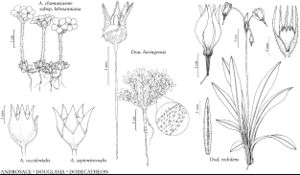Douglasia
Quart. J. Sci. Lit. Arts [ 24]: 385. 1827, name conserved ,.
Herbs perennial (biennial in D. alaskana), usually cushion- or mat-forming, sometimes succulent (often suffrutescent). Rhizomes absent; roots slightly fibrous or a taproot. Stems prostrate to ascending, simple or dichotomously branched. Leaves in multiple basal rosettes (single rosette in D. alaskana), simple; petiole absent or obscure, broadly winged; blade linear to broadly lanceolate, spatulate, or cuneate, base attenuate, margins entire or slightly dentate, apex acute to obtuse, sometimes 3-toothed, surfaces glabrous or hairy, hairs simple, branched, or stellate. Scapes usually several per rosette, elongating until fruiting. Inflorescences umbels, 2–10-flowered, involucrate, or solitary flowers; bracts absent or 1–10. Pedicels absent or ascending, erect in fruit. Flowers homostylous; sepals 5, green, keeled at least on tube, calyx broadly campanulate, 5-angled, glabrous or stellate-hairy, lobes not reflexed, length ± equaling tube; petals 5, pink, rose, or purple, sometimes turning white or violet in age, corolla salverform, constricted at throat, lobes not reflexed, shorter than tube, apex entire or erose; stamens included; filaments indistinct; anthers not connivent. Capsules ovoid to globose, valvate, dehiscent to base. Seeds 1–4, brown, 4-angled, oblong, reticulate. x = 18, 19.
Distribution
nw North America, e Asia (Russian Far East), arctic and alpine regions.
Discussion
Species 9 (9 in the flora).
Whether Douglasia should be considered a separate genus, part of a very broadly construed Androsace, or, perhaps, part of a new segregate genus comprising Androsace sect. Aretia, has been a longstanding question and remains unresolved. Molecular analyses (G. M. Schneeweiss et al. 2004) show a distinct clade that includes the North American and arctic Douglasia species; it is part of a larger primarily European group of Androsace species in sect. Aretia. Although morphologically very similar to those Androsace species, the Douglasia clade differs in chromosome number (chiefly 2n = 38) and shows a large range disjunction between the Alps and the Bering Strait. As currently construed, Androsace in the broad sense covers a broad range of morphologies, especially in the little-studied Asiatic sect. Pseudoprimula, which, morphologically and karyologically, is closer to Primula than to other Androsace; other sections such as the Chamaejasme group show lesser but still significant discontinuities. Additional comprehensive genetic analyses of the entire Androsace complex are needed before it will be possible to assess the appropriateness of segregate or aggregate nomenclature. This treatment follows the current, conventional view in North America of a segregate generic status for Douglasia.
Throughout its range, Douglasia shows a pattern of closely related species with narrow distributions. The species differ primarily in the type and placement of hairs on the vegetative parts; these characters are consistent and reliable markers. Molecular markers (G. M. Schneeweiss et al. 2004) support close relationships but also indicate separate branches that support species-level designations as well as separate clades within Douglasia, where arctic species form one group and those of the continental northwest, from Washington to Montana, another.
Selected References
Lower Taxa
Key
| 1 | Leaves in single basal rosette; plants not cushion- or mat-forming | Douglasia alaskana |
| 1 | Leaves in multiple rosettes or plants cushion- or mat-forming | > 2 |
| 2 | Stems ± densely covered with reddish or reddish brown, marcescent leaves; arctic species of Alaska and Canada | > 3 |
| 2 | Stems with green or gray to light maroon leaves (not densely covered with reddish or reddish brown, marcescent leaves); Cordilleran species of northwestern North America and southern Canada | > 6 |
| 3 | Leaf blades usually glabrous adaxially, margin hairs simple | Douglasia arctica |
| 3 | Leaf blades usually hairy adaxially, sometimes only at apex, margin hairs simple, forked, or branched | > 4 |
| 4 | Leaves prominently recurved, blade with simple hairs. | Douglasia ochotensis |
| 4 | Leaves ascending or erect, blade with mostly forked, branched or stellate hairs | > 5 |
| 5 | Calyx and bracts densely hairy, hairs branched and/or stellate. | Douglasia beringensis |
| 5 | Calyx and bracts glabrous. | Douglasia gormanii |
| 6 | Inflorescences 1-2-flowered. | Douglasia montana |
| 6 | Inflorescences (2-)3-10-flowered | > 7 |
| 7 | Leaf blades densely hairy, hairs branched and stellate. | Douglasia nivalis |
| 7 | Leaf blades usually glabrous, sometimes ciliate on margins | > 8 |
| 8 | Leaf blades 1-2 mm wide; involucral bracts lanceolate to ovate- lanceolate. | Douglasia idahoensis |
| 8 | Leaf blades 2-6 mm wide; involucral bracts lanceolate to ovate. | Douglasia laevigata |
